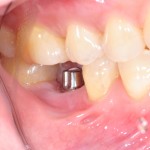
With the increasing placement of dental implants we are seeing a corresponding increase in the peri-implant diseases of mucositis and peri-implantitis. As a result there are increasing reports of peri-implant disease with some studies reporting frequencies of peri-implantitis as high as 47%. Consequently there is increasing interest in the prevention and management of peri-implant disease.
The aim of this review was to assess the impact of supportive periodontal treatment following implant placement on peri-implant disease and survival rates.
Methods
Searches were conducted in the PubMed/Medline, Embase, and Cochrane CENTRAL databases with manual searches in a number of journals ( Journal of Dental Research, Clinical Oral Implants Research, Journal of Clinical Periodontology, Journal of Periodontology, Clinical Implant Dentistry and Related Research, European Journal of Oral Implantology, Journal of Oral and Maxillofacial Surgery, International Journal of Oral & Maxillofacial Implants, Implant Dentistry, International Journal of Periodontics and International of Periodontics and Restorative Dentistry, Journal of Oral Implantology). Clinical studies (prospective or retrospective, randomised, or controlled clinical trials) involving supportive periodontal treatment and non- supportive periodontal treatment groups with at least 1 year follow up post implant loading were considered.
Two reviewers independently screened selected and assessed risk of bias using the Newcastle-Ottawa Scale. Risk ratios (RR) and 95% confidence intervals were calculated, and meta-analysis conducted for incidence of peri-implantitis, and peri-implant mucositis. Meta-regression was used to investigate potential confounding factors.
Results
- 9 studies (5 retrospective, 4 prospective) were included.
- Most of the studies focused on oral hygiene reinforcement and mechanical debridement with specific tools.
- Follow up periods ranged from 1-16 years.
- Meta-analysis (6 studies) showed a significantly higher survival rate in the supportive periodontal treatment (SPT) groups at the patient level, RR = 1.10 (95%CI: 1.07–1.14).
- Meta-analysis (3 studies) showed a lower prevalence of peri‐implant mucositis, RR = 0.57 (95%CI: 0.43–0.76) and peri‐implantitis, RR= 0.25 (95%CI: 0.13–0.48) in SPT groups.
Conclusions
The authors concluded: –
..supportive periodontal treatment (SPT) can potentially improve peri‐implant health in terms of implant survival rates (SR), prevent peri‐implant mucositis, and peri‐implantitis. Additionally, the correlation in recall interval and adjunctive use of chemical agents during SPT to implant SR and incidence of peri‐implant mucositis and peri‐implantitis could not be found in the present review. In the future, more well‐controlled studies with consistent and complete data are required for investigating the efficacy of SPT.
Comments
A broad search strategy was used to identify relevant studies however only English language papers were included so relevant studies could have been excluded. In addition, a majority of the included studies are of retrospective design so are subject to a greater risk of bias. There was heterogeneity in the types of SPT programmes used in the included studies with 3 of the 9 studies using supportive agents including antibiotics, antiseptics or fluoride get during treatment and recall intervals also varied between studies.
In 2016 we looked at an earlier review of maintenance treatment for preventing peri-implant disease (Dental Elf – 15th Jan 2016). That review included 13 studies and only 2 of the studies included in this new review were published after 2015. So while the available evidence suggests some benefit from SPT there is still a shortage of good quality evidence. So, high quality, well conducted and reported prospective studies are needed in order to clarify the evidence regarding the prevention and management of peri-implant disease.
Links
Primary Paper
Lin CY, Chen Z, Pan WL, Wang HL. The effect of supportive care in preventing peri-implant diseases and implant loss: A systematic review and meta-analysis. Clin Oral Implants Res. 2019 Aug;30(8):714-724. doi: 10.1111/clr.13496. Epub 2019 Jul 21. Review. PubMed PMID: 31231883.
Other references
Dental Elf – 15th Jan 2016
